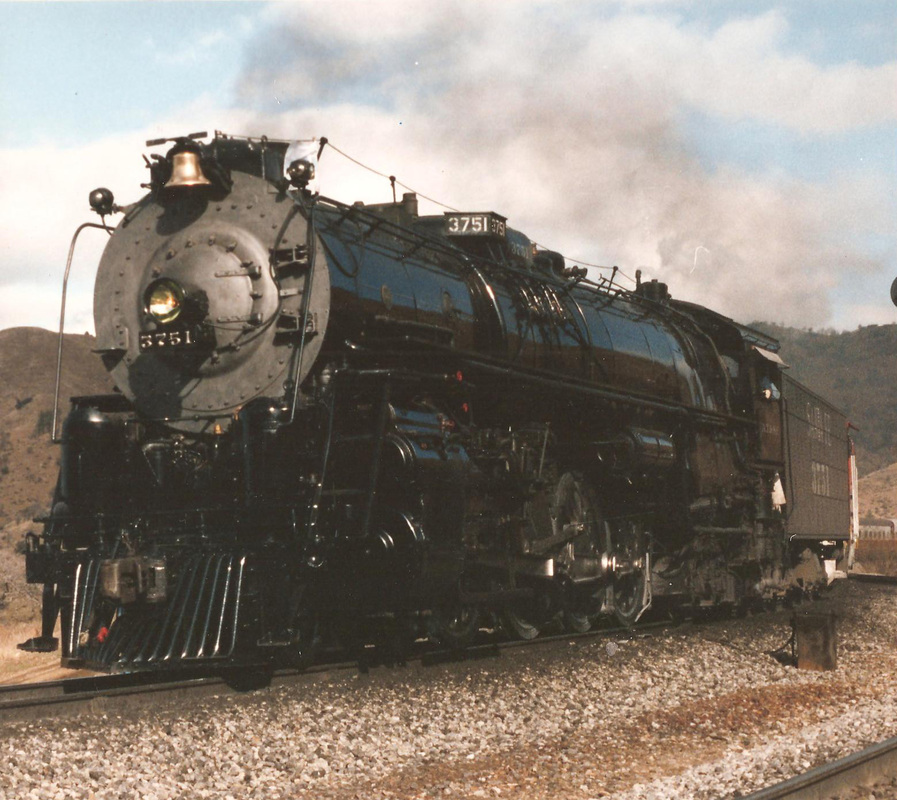Atsf 3751 History

Two possibilities, and likely some of both ...
Santa Fe 3751 West down the Peavine and Arizona California 8/25/2002. It was a great train ride down the Peavine Line and once we got onto the Arizona California they announced we would do a runby at Via. We detrained right in the middle of town with the locals all wondering what the heck was going on. Records for #3751 Santa Fe No. 3751 was the first 4-8-4 locomotive built by Baldwin, designed jointly by Santa Fe and Baldwin engineers. It was Santa Fe's first 4-8-4, and on May 7, 1939 it had the distinction of pulling Santa Fe's first passenger train, The Scout into Los Angeles Union Passenger Terminal on opening day. Its highest recorded speed.
1) Amtrak passenger equipment is now all-electric, and runs off 'Head
End Power' (HEP) rom the locomotive. This runs the lighting, air
conditioning, etc. It's pretty heavy 'AC' service, and the steam loco's
tiny generator is entirely inadequate ('DC', and the wrong voltage) for
such service.
Steam loco generators (steam turbo-gens) are normally just for the
locomotive's own lights (headlights, class lights, cab lights, etc.).
Atsf 3751 History Museum
'Back then', passenger cars were heated, and sometimes cooled, with
steam provided by the locomotive. This made sense when the locomotive
could provide plentiful steam. When Dieels came into service, all the
trains still needed steam. Early Diesel and electric passenger locos
carried oil-fired steam generators (boilers, or more usually flash steam
generators) to serve their train. In very cold weather, or when using a
loco without steam capabaility, a 'steam generator car' was often added
to the train to provide additonal steam capacity. This continued into
the early days of Amtrak, until 'HEP' was adopted as standard. It took a
few years to transition to the new power requirements.

Early car electric lighting, if used (often 32 volt DC), came from a
bank of batteries under each car, recharged by mechanicaly-driven
generators coupled to the car's wheels by shaft or belt. Same for most
cabooses. Today for passenger cars, it's all 'HEP', all 'AC', and
cabooses are all but gone anyway. Th eonly exceptions are antiue cars
sometimes operated in 'museum trains'. Even older passenger cars still
in service, like private cars, are now converted to 'HEP'.
ATSF 3751 in Vincent Grade/Acton California in September 2016. 3751 became the first steam locomotive to travel north of Los Angeles in 24 years. Headshot of 3751 ATSF 3751 in Sais, NM. Add a photo to this gallery. ATSF 3751: Description: A progress shot of the 3751 seen from East Redondo. The steam in the engine should return sometime after November 2019. Photo Date: 9/15/2019 Upload Date: 9/15/2019 2:50:52 PM: Location: Los Angeles, CA: Author: Jonathan Camacho: Categories: Locomotives: ATSF 3751(4-8-4) Views: 310 Comments: 0. The train was officially BNSF OLACSAE13 RailFair'99 Special. #3751 was the ATSF's first ever 4-8-4 Northern (thus, the 3751 Class engine on Santa Fe), having been delivered by Baldwin Locomotive Works in May 1927.
Atsf 3751
2) The railroad being used (usually NOT Amtrak, who own very little
trackage), requires 'protection power' (a second locomotive) in case
there's some breakdown on the road. Nowadays this is almost always the
case whenever any steam loco moves over any railroad. Tourist lines
avoid it if they own their own track and can make the rules, and
occasionally a railroad will allow a lone steamer to operate ... but
that's quite rare.
